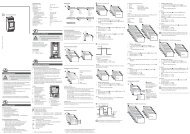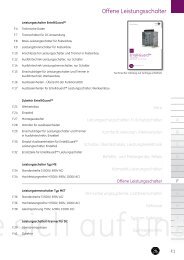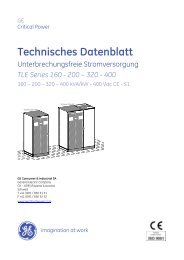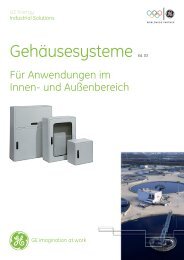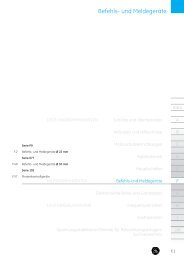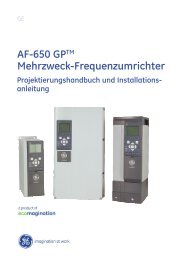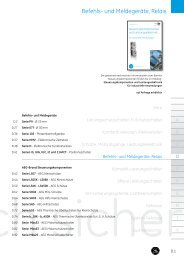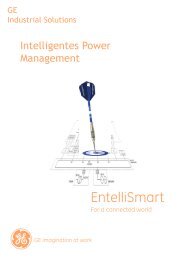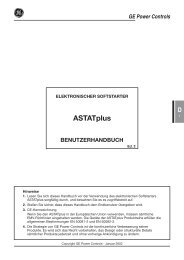GE Consumer & Industrial - G E Power Controls
GE Consumer & Industrial - G E Power Controls
GE Consumer & Industrial - G E Power Controls
You also want an ePaper? Increase the reach of your titles
YUMPU automatically turns print PDFs into web optimized ePapers that Google loves.
3.2.5 ED impulse coil release (Code 12)<br />
<br />
<br />
<br />
<br />
<br />
<br />
ED impulse release requires an external protective relay<br />
for monitoring a current increase. This relay must be<br />
provided and installed by the customer.<br />
If a fault occurs, an external relay signal wired into the<br />
capacitors’ control unit (internal NEKO or external C-bank),<br />
causes NEKO unit to discharge its energy into ED coil [Fig.<br />
8]. The coil trips the breaker’s quick latch and opens<br />
breaker’s contacts in less 3ms.<br />
ED impulse release is an optional accessory. Complete set<br />
consists of ED coil and electronic control unit with C-bank<br />
called NEKO. The external release signal shall be 8 V to<br />
24 V DC, and shall be connected at terminals (-X2 :10 /<br />
:11) in standard wiring scheme.<br />
Customer supplied capacitor trip unit may be used. Rated<br />
voltage of 300 V and capacity of 2 000 µF is required. In<br />
this case only ED coil will be installed in the breaker.<br />
WARNING: Firing signal voltage level is between 8 V and<br />
24 V. There should be no spikes on the signal of duration<br />
less 3 ms. This can lead to defect of the NEKO board!<br />
WARNING: Maximum duration of the firing signal must<br />
not exceed ~1 sec. Longer signal can lead to NEKO<br />
overheat! It is recommended to use an auxiliary contact<br />
in serial connection with firing circuit (-X2 :10/:11). It will<br />
automatically cut off the firing circuit after breaker<br />
opening.<br />
<br />
<br />
<br />
<br />
<br />
The UVR [Fig. 9] is used for remote actuation and, in<br />
combination with an internal electronic control, for<br />
voltage control.<br />
The UVR releases at voltage interruption or supply voltage<br />
drop below 20 V. In these cases UVR trips the breaker. It is<br />
therefore possible to use this device in combination with<br />
the electronic trip unit for voltage monitoring, where an<br />
unintended re-start of machines after a temporary<br />
voltage breakdown is to be prevented.<br />
The UVR is intended for continuous operation. Its rated<br />
power is 10 W.<br />
Due to its operational mode, the UVR is a self-monitoring<br />
device, i.e. when the breaker is tripped upon a break of<br />
the pilot wire (EMER<strong>GE</strong>NCY-OFF principle).<br />
NOTE: Manual closing of the breaker with ST installed,<br />
while pushbutton OPEN is pressed and control power<br />
applied, might lead to ST coil’s overheating and damage.<br />
Fig. 9 Zero voltage release<br />
3.2.7 Forced tripping release (Code 13)<br />
<br />
Optionally, the forced tripping release (FT) can be installed<br />
in the breaker [Fig. 10a]. This unit mechanically trips the<br />
breaker, by pressing the pin against the bottom plate.<br />
Force required to trip the breaker is about 30 N (~7 ft-lb).<br />
The tripping pin position is as on Fig. 10b.<br />
Fig. 8 ED impulse coil with seesaw interface<br />
3.2.6 Auxiliary tripping devices (Code 11)<br />
<br />
<br />
<br />
<br />
<br />
The breaker can be equipped with either a shunt trip (ST)<br />
or a zero voltage release (UVR). It is not possible to have<br />
both devices installed in the same breaker. Both devices<br />
are interchangeable.<br />
In standard configuration, internal voltage converter<br />
(Code 8) transforms external voltage into 24 V DC, which<br />
is required by ST or UVR. Both devices are tripped by a<br />
potential free contact connected as shown in section 4.2.<br />
Optionally, ST can be connected directly to external<br />
voltage. In this case extinguish capacitors and diode is<br />
used to improve switching of the shunt trip’s coil [Fig 19-<br />
4c]. Double winding shunt trip is available with this option<br />
for 110/125/220 V DC external control supply.<br />
Optionally, it’s possible to supply both devices directly to<br />
external 24 V DC ( 5%). In this case the release signal for<br />
ST shall not be longer 100 ms.<br />
The ST is used for remote actuation. It is designed for<br />
short time operation with max. duty cycle of 9 %. ST’s<br />
supply is connected through auxiliary contacts, which cut<br />
off supply voltage after opening. This protects ST against<br />
overheating.<br />
F~30 N<br />
Fig. 10a Forced tripping release<br />
(~0.6 in)<br />
(~0.3 in)<br />
8 Design and specifications are subject to change without notice S47183R01E06 2012-11-21





